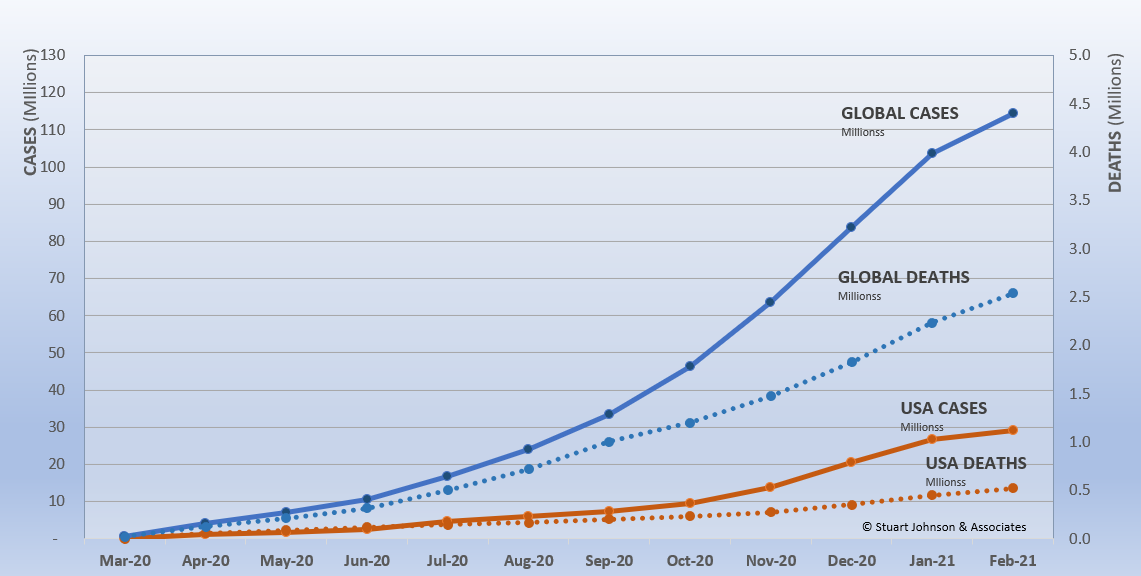






See listing of Recent and Most Popular articles on the Home Page
Health & Wellness
Category: News & Current Events / Topics: COVID-19 • Crisis • Dying and Death • Disease • History • News • Statistics
COVID-19 Numbers for February 2021
by Stu Johnson
Posted: March 4, 2021
A downturn in cases, vaccinations accelerating, but are we out of the woods yet? How does the U.S. compare to the world?…
Putting the COVID-19 pandemic in perspective (Number 8)
See a list of all of my articles related to COVID-19
This series was spawned by my reaction to reporting on the COVID-19 pandemic that focused on raw numbers. Big numbers are impressive, even frightening, and hard to comprehend. Rarely have we been given a context that helps lead to better understanding of the numbers or how to make comparisons between the U.S. and the rest of the world. This series has turned from occasional pieces to a monthly summary setting the U.S. numbers in global perspective. This analysis is based on data from worldometers.info, which monitors 215 countries. From those, I focus on details for 21 countries that have appeared in the top-10 of worldometers metrics since I started more detailed tracking in September 2020.
Report Sections:
• February at-a-glance
• The Continental View • USA Compared to Top-5 Countries
• COVID Deaths Compared to the Leading Causes of Death in the U.S.
• U.S. COVID Cases versus Vaccinations
• Profile of Monitored Continents & Countries • Scope of This Report
February-at-a-glance
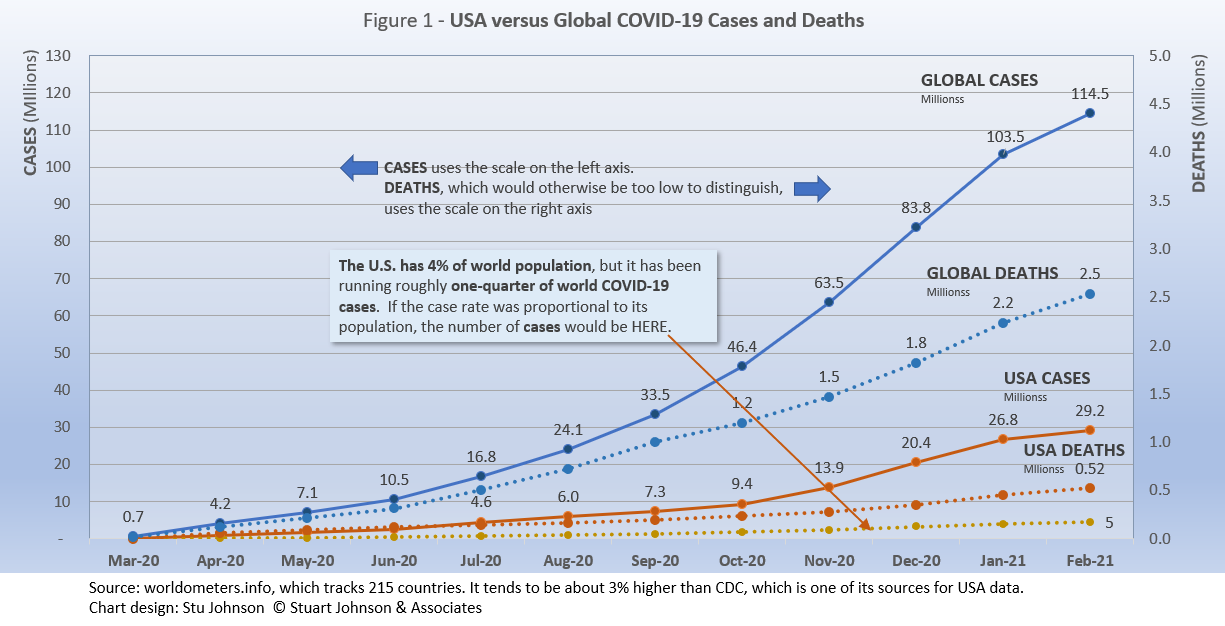
- COVID-19 continued to spread around the world, but after three months of accelerated increase, the curve finally began to flatten in February, with an 11% increase in cases, half the increase for January.
- The pattern for deaths tends to lag behind cases by several weeks, but it increased 14% in February, compared to 23% in January.
- The U.S. continues to lead the world in the number of reported cases and deaths, maintaining the unfavorable distinction of having fully one quarter of world cases with only 4% of world population. The U.S. share of deaths has been closer to 20%—better but still exceedingly disproportionate. Figure 1 shows how much lower cases would be—at about 5-million by now—if they were proportional to the global population.
- The global easing of increased cases and deaths is mirrored in the US, with the increase in cases (9%) below the global rate (11%), while deaths advanced 16%, slightly ahead of the global pace (14%). Both were well below January, where cases increased 31% and deaths 28% over December.
- With vaccinations now available, the U.S. is moving ahead with remarkable speed, though the logistical challenges are so great that there are widespread questions in the media about the performance of the roll-out and numerous complaints from people about the ability to make appointments (see more on this later in the section on vaccinations added last month)..
The Continental View
While COVID-19 has been classified as a global pandemic, it is not distributed evenly around the world.
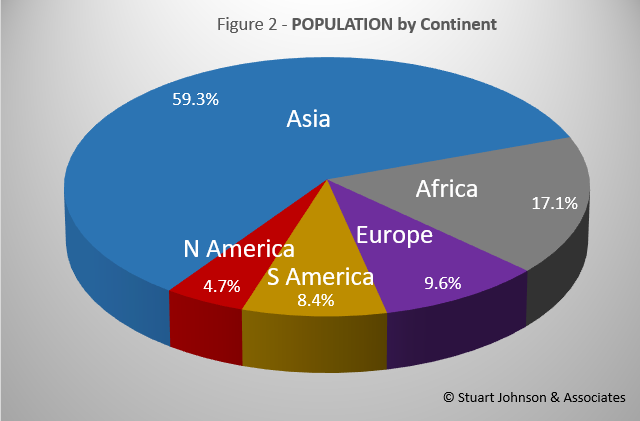
Asia accounts for nearly 60% of the world's population (Figure 2), but only 22% of COVID cases—affecting only 0.4% of its population—in February (Figure 3A). In fact, where Asia and Africa combined represent about three-quarters (76.4%) of the world's 7.8-billion people, Europe, South America and North America account for roughly three-quarters (75.4%) of cases (Figure 3A) and 80.2% of deaths (Figure 4A).
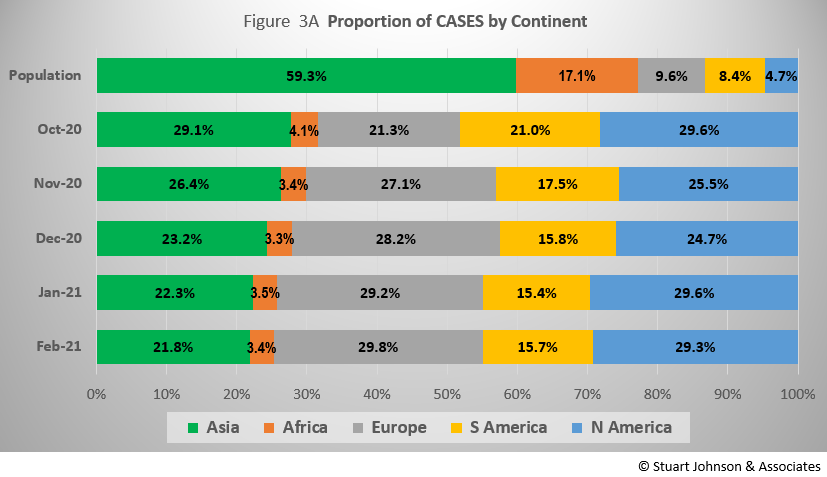
Asia is nearly equal in number of cases with Europe and North America. That is where it is important to remember the huge difference in proportion. That lack of proportionality is what led me to start analyzing the COVID numbers. The high numbers of the U.S. (a genuine cause for concern) were being made even worse by being compared with individual European countries. Even though Europe has twice the population of the U.S., it would still be better to compare the U.S., with its fifty states, to all of Europe, with its constituent countries.
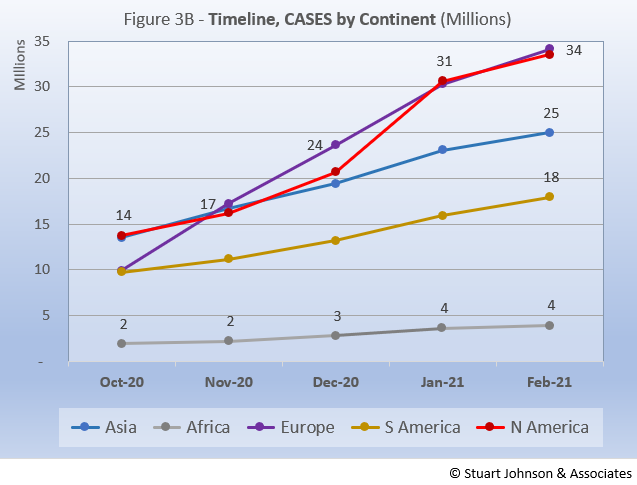
Figure 3B shows a fairly steady increase in cases for Africa, South America and Asia. In contrast, Europe, which had been on the low end through the summer, began to escalate in September, with a nearly straight-line climb, surpassing North America in November and continuing on to 34-million cases in February. North America was pretty close to Asia in number of cases through November, moved ahead slightly in December (having been surpassed by Europe in November), shot up in January to catch up with Europe, then settled into a slower rise, with both Europe and North America ending close to 34-million cases.
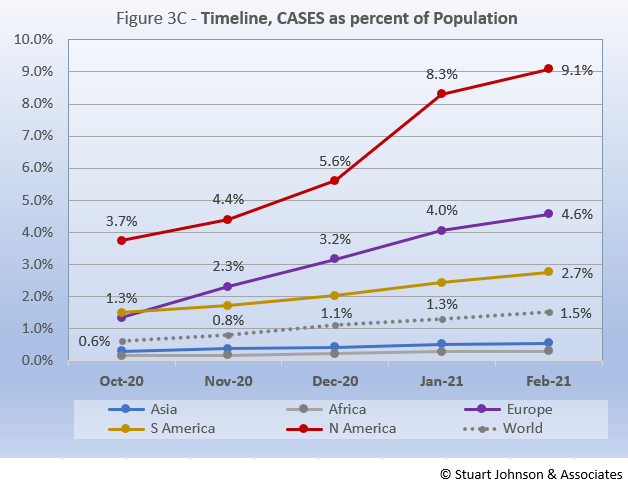
Remembering proportionality, however, North America should not be equal to Europe in impact. Figure 3C, which translates raw case numbers to percentage of population, makes this clear. After a sharp rise in January, North America slowed its growth, but still ended February with cases at double the proportion of population as Europe. Asia and Africa continue at a pace well below the global rate, which hit 1.5% of population in February.
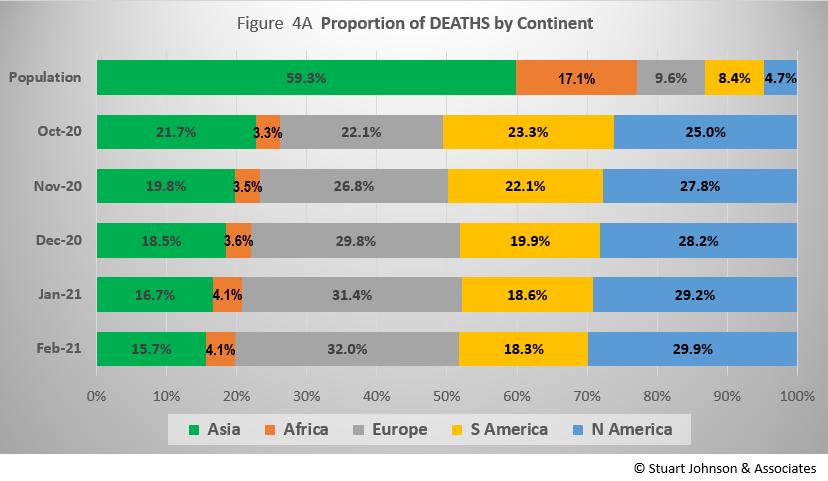
The proportion of deaths between continents is even more distorted than that of cases. Figure 4A shows the steady increase in the proportion of deaths in Europe and the Americas. February ended with Asia and Africa (76.4% of world population) accounting for just under 20% of COVID deaths. Europe has increased from 22% in October to 32% in February, while North America increased half that rate and South America declined by half that rate.
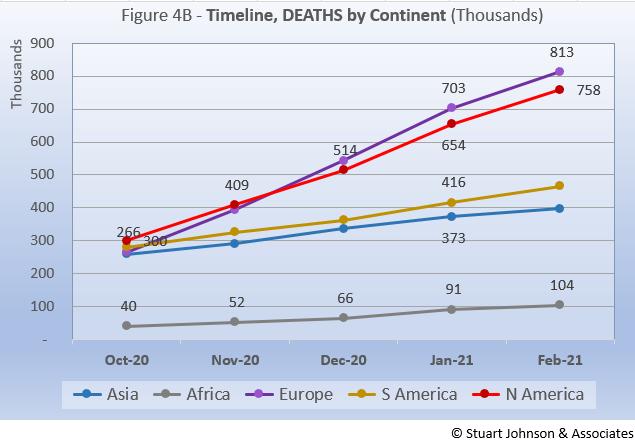
The overall distribution for deaths in February shows how the trajectory for deaths lags behind cases. The downturn in deaths from January is barely discernible (Fig. 4B). Starting nearly together in the number of deaths in October, Europe surpassed North America in December, while both ended February far ahead of South America and Asia, which rose at a more moderate pace. Africa continues its own solo track, though its rate of increase is not that far behind South America and Asia,
Comparison of U.S. to Top-5 Countries
Cases
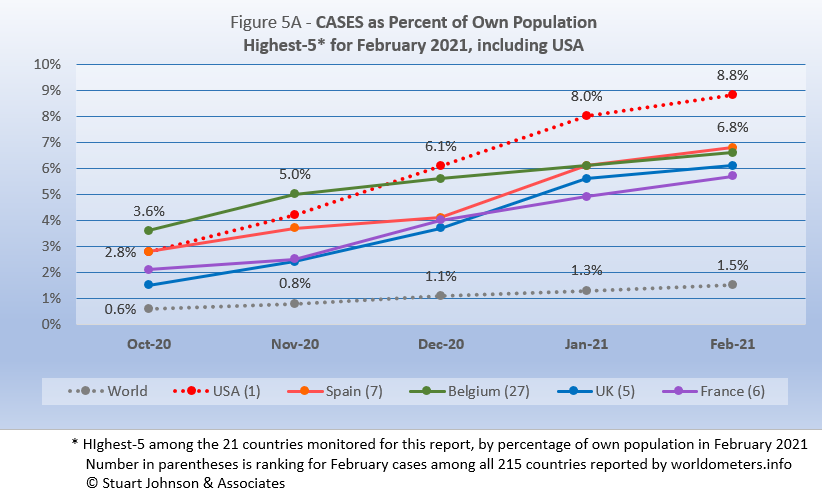
Early on, the small European country of Belgium was leading the world in COVID cases as a proportion of its population (Figure 5A). The U.S. and Spain were nearly a full percentage point lower in October. Belgium began to level off in December, while the U.S. continued climbing, with a slight acceleration in December that continued into January. Spain was a bit more of a roller coaster—up in November, slowing in December, than rising to parallel the UK in January. France appeared to be headed the same way as the UK, but slowed in January.
One measure that helps show the impact of the number of cases is to realize that
the presence of COVID cases around the world represents 1 in every 68 people (down from 1 in 76 in February). For the top-5 cases as a percentage of population, however, that means 1 in 17 for France and 1 in 11 for the U.S.
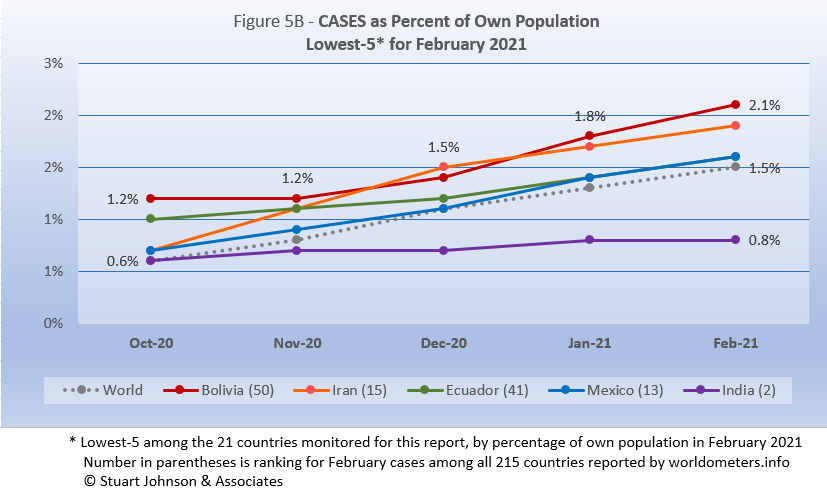
At the low end (Fig. 5B), the five lowest countries for cases by proportion of population (among the 21 that we track) are much closer to the global figure of 1.5% of population with confirmed cases of COVID-19 at the end of February. Those countries represent a considerable spread in size, from India, the second largest country, to Bolivia, ranked number 50 of the 215 countries tracked by worldometers.
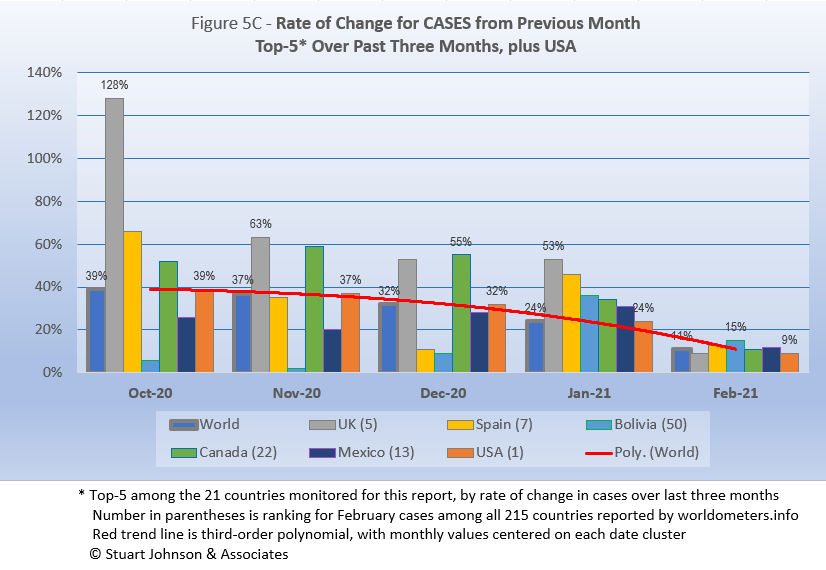
Because the size of countries makes the use of raw case numbers illusory, another measure I find helpful is the rate of change from month to month (Figure 5C). The overall trend in global change from month to month (red line) is going down, most noticeably between December and February. The variation between the top-5 each month has been significantly reduced, with increases in cases among the top-5 (by level of change) for February all much closer to the global level of change (11% over January) than any previous month. News reports during the writing of this report, however, indicate that COVID cases have begun rising again in Europe, so it would be unwise to make predictions based on the past month or two. .
After seeming to have shown more discipline than America, the UK began facing a real surge of cases in late summer and early fall (even before reports of a more easily transmissible variant of the virus), with cases in October more than double (128%) September. It has tapered off since then, finally falling to a level below the global increase in February.
Spain was slowing markedly, then jumped 48% in January, but settled back to near the global change in February. Mexico and Bolivia were both below global increases through December, then joined the top-5, all above global increases for January, with Bolivia reflecting a surge-like increase, while Mexico's was more a leveling off from December. Both were back down to global levels in February. The U.S. started below the global increase in October, moved higher in November, leveled off in December before falling in January, though still at a rate above the global level of change. The U.S. ended February with a 9% increase over December, below the global level, but missing the top-5 over three months by only one place.
Deaths
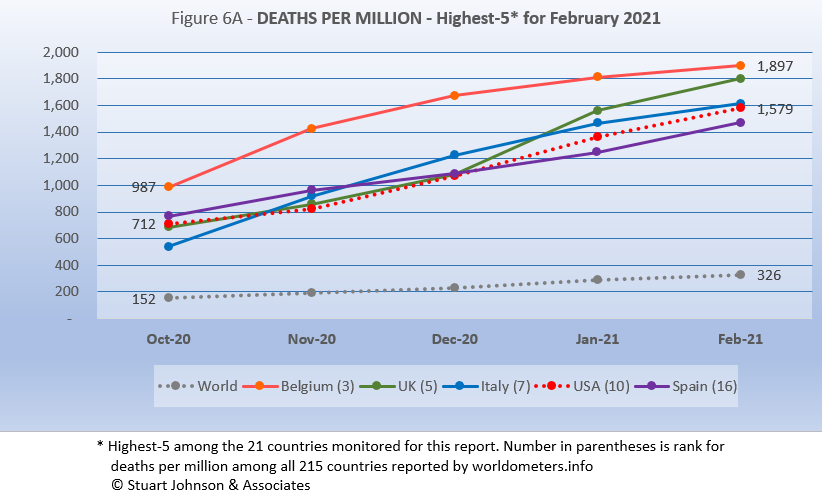
Because deaths as a percentage of population is such a small number, the "deaths per million" metric provides a comparable measure. As Figure 6A shows, Belgium leads the world, though its rate has been slowing as other countries continue to rise. The remaining top-5 for January all tracked in a narrow band through December, then started to break apart somewhat, though still within a relatively narrow range—and all well above the global level of 326 deaths per million population (0.03%).
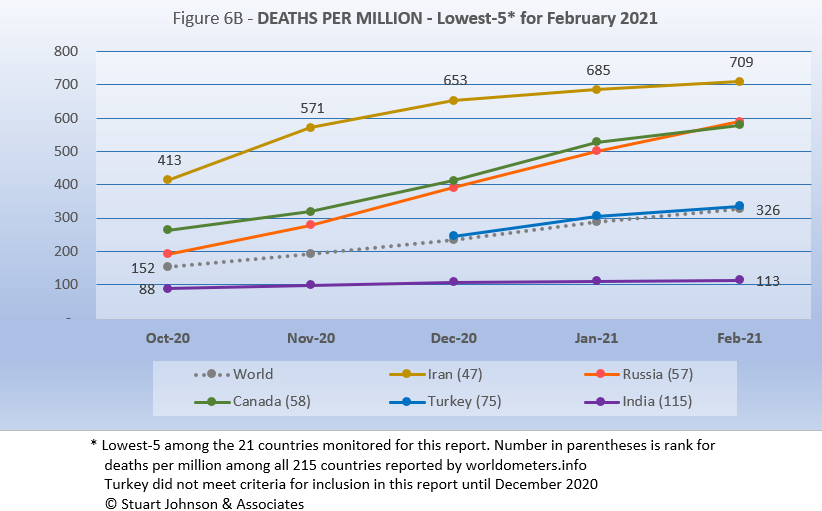
At the low end of deaths per million (Fig. 6B), Turkey has tracked at the global level since it reached the criteria needed to be included in this report (even though it is the top-10 by population). Except for Canada, the other four are all outside the hardest hit regions.
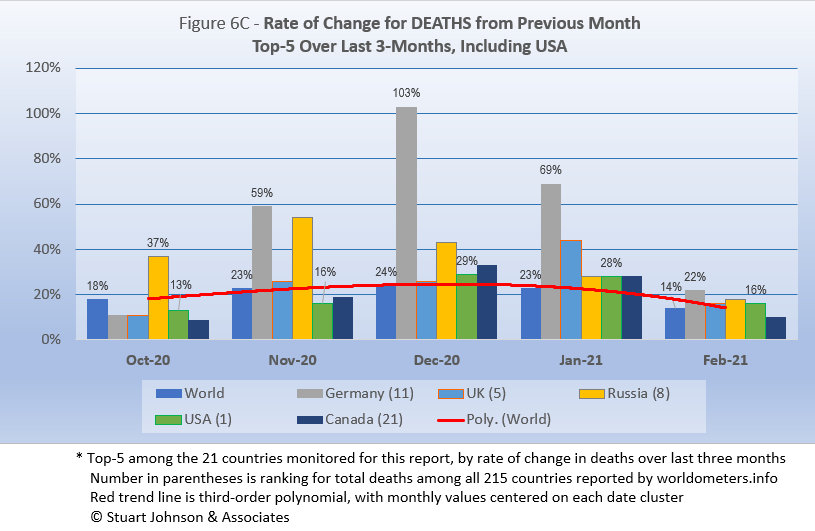
The trend in the rate of change in deaths (red line in Figure 6B) shows the delayed connection with cases. While monthly changes for cases were trending down since October, for deaths the trend peaked in December before starting to go down. ending February at 14%, the lowest level since October.
The chart shows the serious situation faced by Germany, which saw deaths increasing at alarming rates in November and December, then falling off some in January, but still 25 points higher than the UK, which surged that month. Germany dropped noticeably in February, but still higher than the global level (21% compared to 14%).
While the UK hovered around global levels of increase through December, it made a noticeable climb in January, with a 44% increase over December. In February the UK fell back to just above the global level. The other top-5 countries in February followed a pattern of rising increases in November and December before slowing in January. The U.S. peaked in December, stayed nearly the same in January, before falling to 18% in February, close to the global change of 14%.
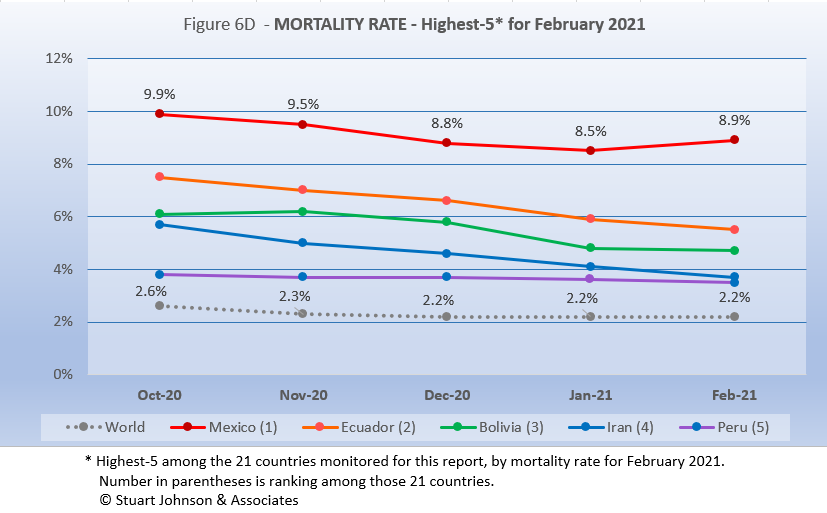
Mortality Rates (percentage of deaths against reported cases) have been slowly declining. This is not surprising as several factors came into play: the ratio of community spread versus outbreaks (nursing homes, similar confined settings) increased, lessons being applied to treatment, and increased testing (which would expand the spread between reported cases and deaths). .
The top-5 in mortality rate (among the 21 countries observed) stand out because for the most part they do not show up in other charts and also tend to be low on levels of testing. Mexico is far above other countries in mortality, actually moving back up in February after steadily decreasing each month.
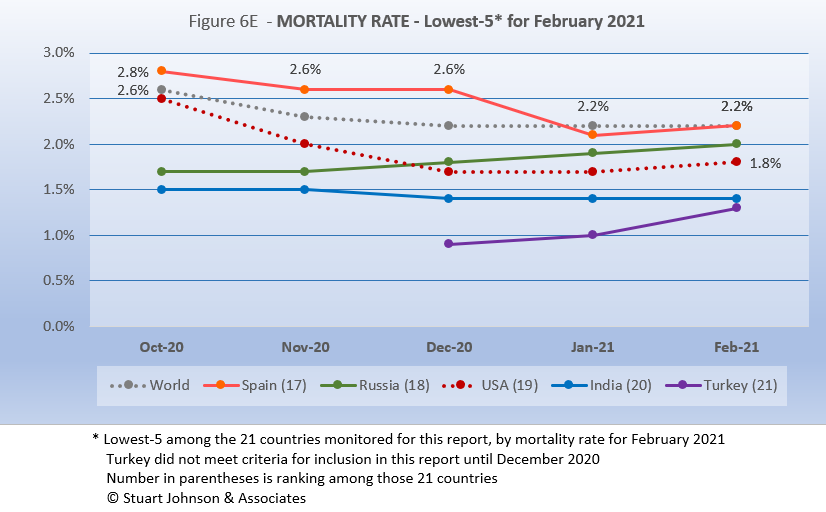
The U.S., while number 1 in cases and deaths, is number 19 in mortality of the 21 countries monitored for this report, It has been below the global level, increasing its spread until February when it rose one-tenth of a percent to return to the previous low of 1.8% in December. It had fallen to 1.7% in January, but the rise represents the delayed response of deaths following the earlier rise in cases during the holidays. Spain had a similar pattern, hitting a low in January, then coming back up a tenth of a percent in February. India is trending down very slowly, while Russia and Turkey are bucking the global trend by increasing each month.
How real is the threat of death from COVID? That's where successful mitigation comes in. Worldwide, by February, 1 in 3,079 people have died from COVID. In the U.S., while the mortality rate is low, because the number of cases is so high, 1 in 636 have died through February (down from 1 in 737 in January and 1 in 924 in December). With low mortality, the U.S. should have been able to keep deaths much lower, but the extraordinarily high number of cases means more deaths. Without a better-than-global mortality rate, the U.S. death rate would be far higher. The response of the health care system is part of keeping mortality down, but it's far too early to detail the cause for that positive piece of the COVID picture in the U.S.
Tests
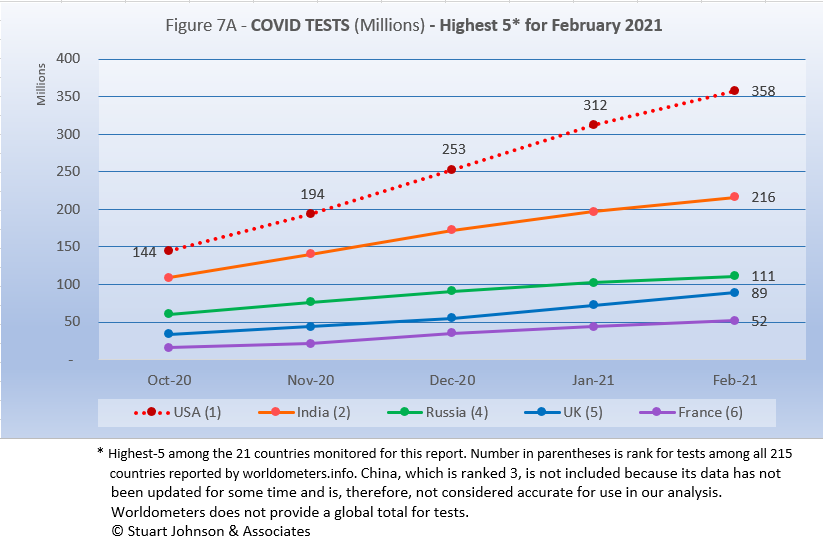
The U.S. is far ahead of other countries in reported COVID tests administered, at 358 million, 65% ahead of India. These are raw numbers, though, so it is important to recognize the size of the country. It is also the case that COVID tests can be administered multiple times to the same person, so it cannot be assumed that the U.S. has tested almost all of its population of some 330-million. The University of Illinois at Champaign-Urbana, for example, is using a twice-weekly saliva test for its campus population to monitor the situation very closely. That's a lot of testing in one place.
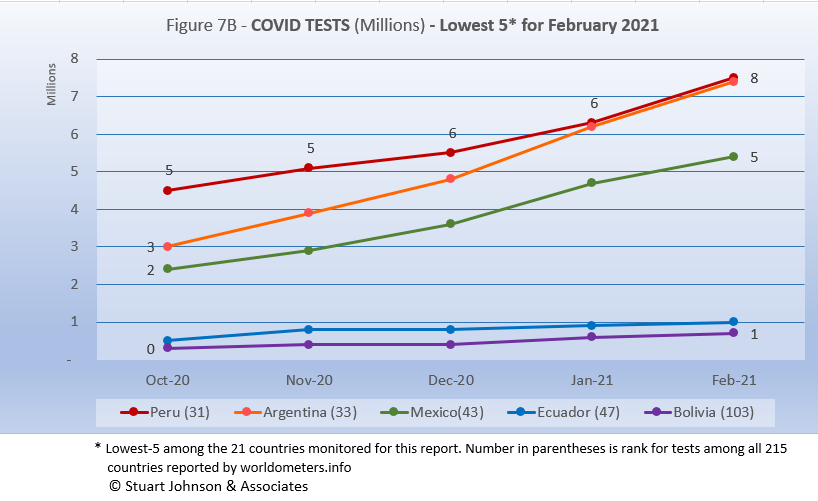
There is tremendous disparity between countries in terms of testing. The five countries (among the 21 monitored) with the lowest reported number of tests are all in South America. Peru and Argentina are good examples, both having achieved close to 8-million tests by February. Argentina (7.4-million tests for its 45-million population) is well below Spain (38.5-million tests and a population of 47-million). Similarly, Peru (7.5-millions test and 33-million people) is also well below Canada (24.3-million tests and 38-million people).
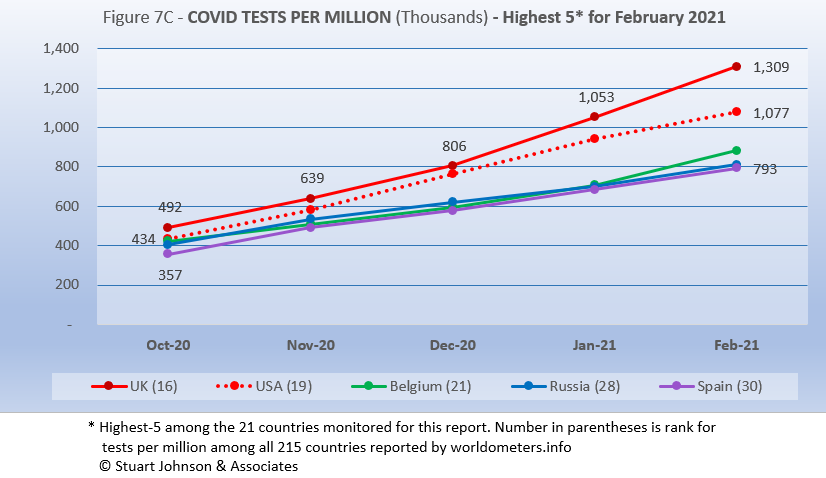
Tests per million adds another perspective. Fig. 7C shows the five ciountries with the highest tests per million. It shows that the UK has been most aggressive in testing, followed by the U.S., with Belgium, Russia and Spain all around the 790 mark. Anything over 1,000 represents more tests than people (1,000 on the chart actually means 1,000,000), but as mentioned above, that does not mean that everyone had been tested. Some people have been tested more than once, and some are being test regularly or with increased frequency.
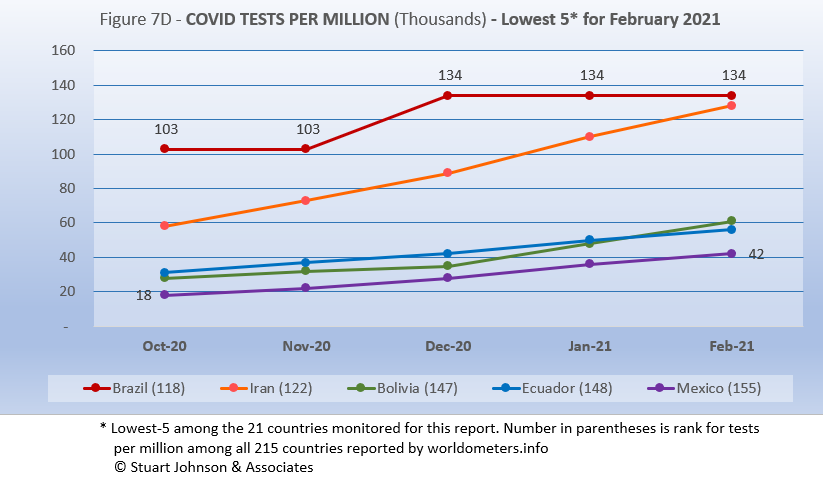
The five countries among the 21 monitored with the lowest tests-per-million (Fig. 7D) is a different mix than the five countries with the lowest number of tests, which were all in South America. Here, three are South America, one North America, and one Asia. All represent very low levels of testing, no more than 13% at the most. .
Causes of Death in U.S.
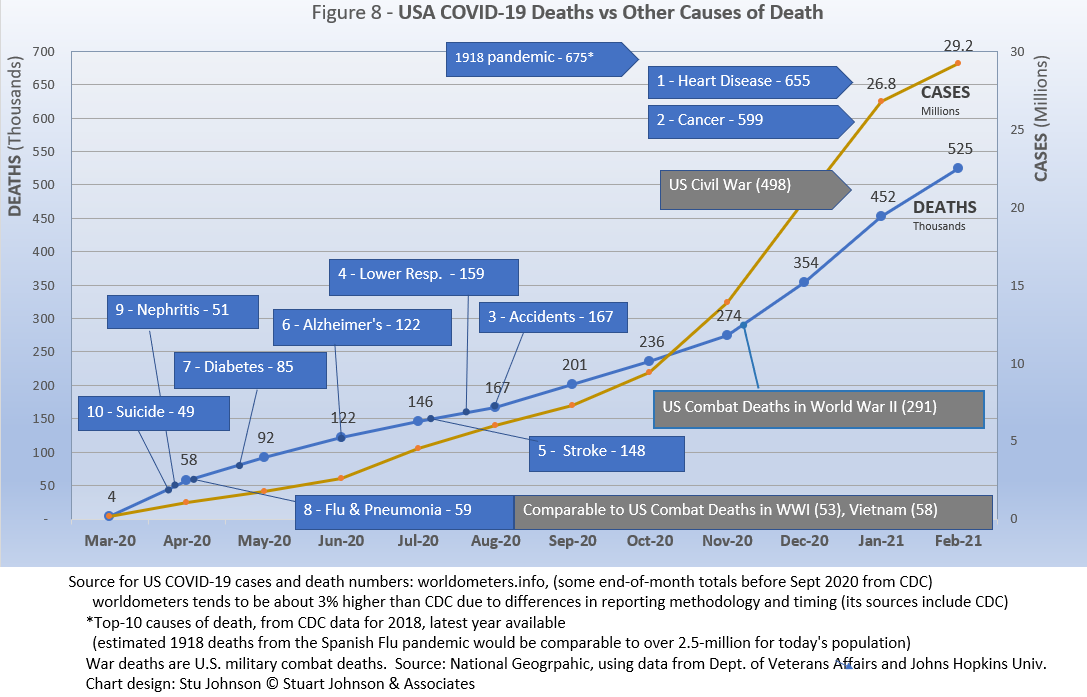
Early in the reporting on COVID, as the death rate climbed in the U.S., a great deal of attention was given to benchmarks, most notably as it approached 58,000, matching the number of American military deaths in the Vietnam War. At that time, I wrote the first article in this series, "About Those Numbers," in which I looked at ways of viewing the data, which at the time of that writing in May 2020 was still focused on worst-case models and familiar benchmarks, like Vietnam. Part of my approach in that article was to put the U.S. COVID deaths on a timeline against not only mileposts like war deaths or significant numbers (i.e., every 50,000 or 100,000), but against the reality of the top-10 causes of death each year, numbers available from the CDC.
Most media sources reported that the U.S. would pass 500,000 deaths on February 22, 2021. The CDC reported 497,415 deaths on February 21, while worldometer.info was already reporting 512,068. As mentioned elsewhere in this report, worldometer tends to be about 3% ahead of CDC and Johns Hopkins, a matter of a few days difference in data collection. At any rate, it is clear that February saw the U.S. death toll from COVID pass the 500,000 mark. .
Figure 8 shows the number of U.S. COVID cases and deaths against the top-10 causes of death reported by CDC for 2018 (the latest year available), along with several other mileposts from wars and the 1918 pandemic. Notice that for nearly nine months, the curve for deaths was increasing at a faster rate than cases. Then, starting in November the curve for cases took a decided turn upward, while deaths increased at a more moderate pace. The February slowdown in cases was met by a barely perceptible slowdown in deaths, because as pointed out earlier, deaths trail changes in cases, so we should expect to see the curve for deaths decline more noticeably in March, if indeed the trend is real. .
The chart shows that the U.S. surpassed the third leading cause of death, accidents (167-thousand per year), back in August. There was a long way to go to reach number 2, Cancer, with 599-thousand deaths in 2018. The U.S. also passed its combat deaths in World War II back in November (291-thousand—though most media outlets focused on a 400-thousand milepost that would include non-combat deaths).
The chart also shows a slight leveling off in deaths early on, indicating some success in trying to "flatten the curve," but then the pace picked up slightly from August to November, and again into November and January for a holiday surge, ending the most recent month at 525-thousand COVID deaths. That means that we passed the next major milestone, military deaths from the Civil War, at 498-thousand—and closing in on the 599-thousand claimed in 2018 by cancer. We're beginning to hear the specter of 600-thousand dead sometime in 2021, but the latest "Ensemble Forecast" from CDC suggests this for the immediate future:
...the number of newly reported COVID-19 deaths will likely decrease over the next 4 weeks, with 4,400 to 12,900 new deaths likely reported in the week ending March 27, 2021. The national ensemble predicts that a total of 540,000 to 564,000 COVID-19 deaths will be reported by this date.
Note: As I've referenced in the notes for several charts, the data from worldometers.info tends to be ahead of CDC and Johns Hopkins by about 3%, because of reporting methodology and timing. I use it as a primary source because its main table is very easy to sort and provides the relevant data for these reports.
Perspective
The 1918-19 Spanish Flu pandemic is estimated to have struck 500 million people, 26.3% of the world population of 1.9-billion at that time. By contrast, we're now at 1.5% of the global population. Deaths a century ago have been widely estimated at between 50- and 100-million worldwide, putting the global mortality rate somewhere between 10 and 20-percent. It has been estimated that 675,000 died in the U.S.
IF COVID-19 hit at the same rate as 1918, we would see about 2-billion cases worldwide by the time COVID-19 is over, with the global population now at 7.8-billion—four times what it was in 1918. There would be 200- to 400-million deaths. The U.S. is estimated to have had 27-million cases (one-quarter of the population of 108-million) and 675,000 deaths. Today, with a population of 330-millions (a three-fold increase from 1918) this would mean more than 80-million cases, and 2- to 4-million deaths.
However, at the present rate of confirmed cases and mortality while the total number of global cases could approach 500 million or more—comparable to 1918 in number, that would be one-quarter of 1918 when taking population growth into account . .. and assuming the pandemic persists as long as the Spanish Flu, which went on in three waves over a two year period. With vaccination in progress and expected to be completed in the U.S. by the end of summer, , the end of COVID-19 could come sooner. Like 1918, however, there could be complicating factors such as the growing number of mutations that are more highly transmissible (but not necessarily more deadly).
Using the global mortality rate of 2.2% in February, total deaths with the above projection of cases, would be over 12-million worldwide, tragic but far below the number reported for 1918 (50-million) with an even wider gap (200 million) when taking population growth into account.
The contrast demonstrates the vast difference in scale between the Spanish Flu pandemic a century ago and COVID-19 now. Key differences are the mitigation efforts, available treatment today (though still leaving the health care system overwhelmed in some areas), and the beginning of vaccine distribution. In addition, in 1918 much of the world was focused on a brutal war among nations (World War I) rather than waging a war against the pandemic, which ran its course and was undoubtedly made much worse by the war, with trans-national troop movements, the close quarters of trench warfare, and large public gatherings supporting or protesting the war.
Vaccinations in the U.S.
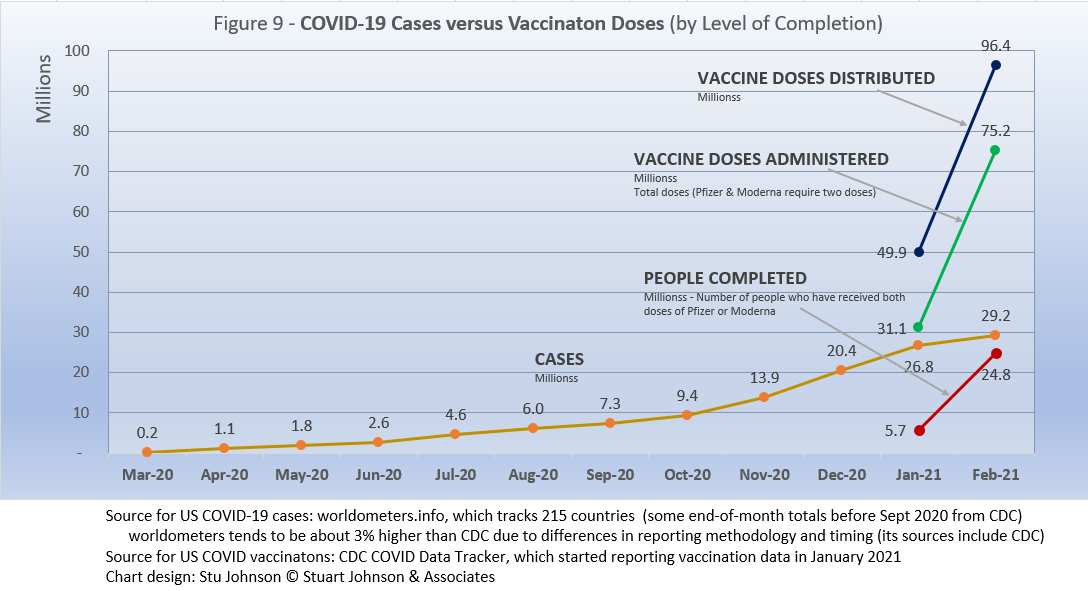
With remarkable speed (it usually takes years to develop vaccines), two COVID vaccines were granted emergency approval for use in the U.S. starting in January—the one by Pfizer requires super-cold storage, which limits its deployment. The other, by Moderna, requires cold storage similar to other vaccines. Both of these require two doses, which means that vaccine dosages available must be divided in two to determine the number of people covered. At the time of this writing, Johnson & Johnson was granted approval for a single-dose vaccine. The numbers in Figure 9 represent the two 2-dose vaccines, reported by CDC as of February 28.
There has been a great deal of anxiety and frustration about vaccine availability. Much of it, I believe, is unwarranted. It is the result of a combination of politics, news reporting focused on highlighting trouble spots (admittedly, even the best journalists tread a razor edge between informing and inciting), and unrealistic expectations among many people fueled in part by social media.
When writing the January report, I personally knew of only a few people who had appointments for their first dose. There has been a lot of confusion, complaints, delays, but at this writing my wife and I both had our first dose of the Moderna vaccine this past Monday and will have the second by the end of the month. We qualify in stage 1B in Illinois, which includes people 65 and older as well as younger, essential workers.
Vaccinating over 300 million people in the United States (much less a majority of the billions around the world) is a daunting task. It is a huge logistical challenge, from manufacture to distribution to administration. Yet, it remains amazing that any of this is possible this soon after the identification of the virus just over a year ago.
Last month I mentioned a headline that talked about the next group in Illinois to be eligible, though it would still take weeks or months to get through those already qualified. A headline yesterday announced President Biden's assurance that enough vaccine would be distributed by the end of May to vaccinate everyone in the U.S.—but the story confirmed that it would still be weeks or months before all of it would be in the arms of those needing it.
There is a delicate balance between maintaining hope with the reality that this is a huge and complicated logistical operation that will take time—and it is a global situation that is beginning to raise issues of equity and fairness within and between countries.
Several people were waiting to be vaccinated when I got my first dose. One was very positive about getting her first dose, then asked if she would still have to wear her mask after the second dose. YES, came the emphatic response from the four other people waiting their turn. YES, even if vaccinated, we will have to continue mitigation efforts until the curve of new cases finally flattens and we can be assured that COVID no longer has a hold on us. That is why the announcements of reopening in Texas, with no restrictions is so worrisome. Thank goodness that many stores and other establishments will still require masks and social distancing. We can grasp the hope that the end is in sight, but let's not throw it away by being foolhardy!
Profile of Monitored Continents & Countries
(Data from worldometers.info).
| Rank | Country | Population | Share of World Population |
Density People per square km |
Urban Population |
Median Age |
| WORLD | 7.82B | 100% | -- | -- | -- | |
| Top 10 Countries by Population, plus Five Major Continents See lists of countries by continent |
||||||
| - | ASIA | 4.64B | 59.3% | 150 | 51 countries | 32 |
| 1 | China | 1.44B | 18.4% | 153 | 61% | 38 |
| 2 | India | 1.38B | 17.7% | 454 | 35% | 28 |
| - | AFRICA | 1.34BM | 17.1% | 45 | 59 countries | 20 |
| - | EUROPE | 747.7M | 9.6% | 34 | 44 countries | 43 |
| - | S AMERICA | 653.8M | 8.4% | 32 | 50 countries | 31 |
| - | N AMERICA | 368.9M | 4.7% | 29 | 5 countries | 39 |
| 3 | USA | 331.5M | 4.3% | 36 | 83% | 38 |
| 4 | Indonesia* | 274.5M | 3.5% | 151 | 56% | 30 |
| 5 | Pakistan* | 220.9M | 2.8% | 287 | 35% | 23 |
| 6 | Brazil | 212.9M | 2.7% | 25 | 88% | 33 |
| 7 | Nigeria* | 206.1M | 2.6% | 226 | 52% | 18 |
| 8 | Bangladesh* | 165.2M | 2.1% | 1,265 | 39% | 28 |
| 9 | Russia | 145.9M | 1.9% | 9 | 74% | 40 |
| 10 | Mexico | 129.3M | 1.7% | 66 | 84% | 29 |
| *these countries do not appear in the details because they have not yet reached a high enough threshold to be included Other Countries included in Analysis most have been in top 10 of one or more categories covered in this report at least one month since October 2020 |
||||||
| Rank | Country | Population | Share of World Population |
Density People per square km |
Urban Population |
Median Age |
| 17 | Turkey | 84.3M | 1.1% | 110 | 76% | 32 |
| 18 | Iran | 83.9M | 1.1% | 52 | 76% | 32 |
| 19 | Germany | 83.8M | 1.1% | 240 | 76% | 46 |
| 21 | United Kingdom | 67.9M | 0.9% | 281 | 83% | 40 |
| 22 | France | 65.3M | 0.8% | 119 | 82% | 42 |
| 23 | Italy | 60.4M | 0.8% | 206 | 69% | 47 |
| 29 | Colombia | 50.9M | 0.7% | 46 | 80% | 31 |
| 30 | Spain | 46.8M | 0.6% | 94 | 80% | 45 |
| 32 | Argentina | 45.2M | 0.6% | 17 | 93% | 32 |
| 39 | Canada | 37.7M | 0.5% | 4 | 81% | 41 |
| 43 | Peru | 32.9M | 0.4% | 26 | 79% | 31 |
| 63 | Chile | 19.1M | 0.2% | 26 | 85% | 35 |
| 67 | Ecuador | 17.6M | 0.2% | 71 | 63% | 28 |
| 80 | Bolivia | 11.7M | 0.1% | 11 | 69% | 26 |
| 81 | Belgium | 11.6M | 0.1% | 383 | 98% | 42 |
Scope of This Report
What we track
From the worldometers.info website we track the following Categories:
- Total Cases • Cases per Million
- Total Deaths • Deaths per Million
- Total Tests • Tests per Million (not reported at a Continental level)
- From Cases and Deaths, we calculate the Mortality Rate
Instead of reporting Cases per Million directly, I try to put raw numbers in the perspective of several key measures. These are a different way of expressing "per Million" statistics, but it seems easier to grasp.
- Country population as a proportion of global population
- Country cases and deaths as a proportion of global cases and deaths
- Country cases as a proportion of its own population
- Cases and deaths expressed as "1 in X" number of people
Who we monitor
Our analysis covers countries that have appeared in the top-10 of the worldometers categories since September 2020. This includes most of the world's largest countries as well as some that are much smaller (see the chart in the previous section).
This article was originally posted on my InfoMatters blog.
Search all articles by Stu Johnson
Stu Johnson is principal of Stuart Johnson & Associates, a communications consultancy in Wheaton, Illinois. He is publisher and editor of SeniorLifestyle, writes the InfoMatters blog on his own website and contributes articles for SeniorLifestyle. • Author bio (website*) • E-mail the author (moc.setaicossajs@uts*) • Author's website (personal or primary**)* For web-based email, you may need to copy and paste the address yourself.
** opens in a new tab or window. Close it to return here.
Posted: March 4, 2021 Accessed 520 times
![]() Go to the list of most recent Health & Wellness Articles
Go to the list of most recent Health & Wellness Articles
![]() Search Health & Wellness (You can expand the search to the entire site)
Search Health & Wellness (You can expand the search to the entire site)
![]() Go to the list of Most Recent and Most Popular Articles across the site (Home Page)
Go to the list of Most Recent and Most Popular Articles across the site (Home Page)
 Loading requested view...
Loading requested view...